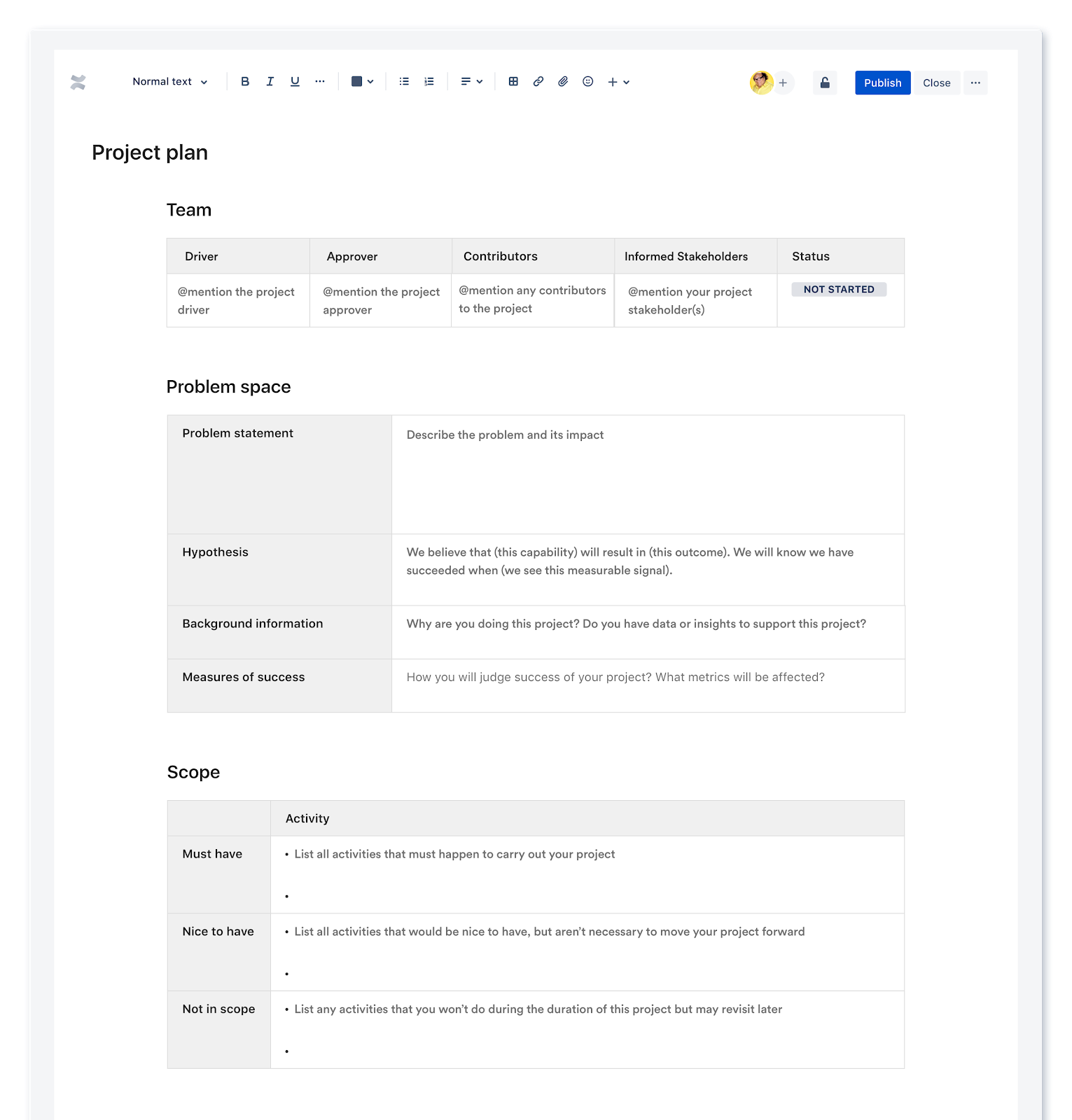项目章程与项目海报:有什么区别?
本文探讨了项目管理中两个基本工具之间的区别:项目章程和项目海报。尽管两者都是启动和规划项目的工具,但它们在具体应用方面存在显著差异。项目章程是一份正式的静态文件,通过概述项目的目的、目标和关键细节,起到基础蓝图的作用。
相比之下,项目海报则是一种动态工具,可提供随项目进展而演变的视觉概述。在接下来的章节中,我们将深入探讨每种工具的独特特点,重点说明项目章程如何为项目奠定正式基础,而项目海报则可作为持续规划和可视化的动态指南,满足项目生命周期中不同阶段的需求。
什么是项目章程?
项目章程或简介是一份概述项目目的、目标和范围说明的简要文档。它标志着正式授权项目启动,同时为项目规划和执行奠定了基础。项目章程通常包含关键信息,例如:
- 项目标题:项目的简短描述性名称。
- 项目目的或理由:项目的目的及其预期收益。
- 项目目标:项目旨在实现的具体、可衡量的目标。
- 项目范围:项目要求的描述,包括具体目标、任务、成本和截止时间。
- 项目交付成果:项目将产生的具体产品或服务。
- 项目利益相关者:在项目中拥有既得利益的个人或团体的列表,例如客户、赞助商和团队成员。
- 项目时间线:项目时间表的简要概述,包括重要里程碑和截止时间。
- 项目预算:完成项目所需资源的估算,包括成本、人员和其他资源。
总体而言,项目章程是所有主要项目利益相关者和项目发起人就项目目的、范围和预期结果达成的共识和协议。它还可作为整个项目管理过程的参考点,以帮助确保项目步入正轨并实现您的目标。
为什么项目海报很重要?
项目章程通过提供结构化基础并提供多种具体好处,在项目管理过程中发挥关键作用。首先,它们可发挥指南针的作用,通过概述项目的目的、目标和范围,为项目团队指明方向。这种清晰度有助于团队齐心协力实现共同目标,同时将出现优先事项分歧的风险降至最低。此外,项目章程通过提前识别潜在的挑战和不确定性,实现积极规划和风险管理策略,为有效的风险缓解贡献力量。
此外,项目章程还有助于优化资源分配。通过详细说明项目要求(包括任务、成本和截止时间),项目章程可确保根据项目需求合理分配人力和财力资源。这反过来又能提高效率,防止出现资源瓶颈。另一个重要优势是,项目章程有助于做出明智的决策。利益相关者在全面了解项目的目的、预期收益和潜在风险后,可以在整个项目生命周期内做出明智的决策。
最后,项目章程可作为利益相关者之间的书面协议,提供工作证明和问责依据。这可以提高透明度,有助于解决项目执行过程中可能出现的争议或误解。总之,项目章程通过提供明确的指导、风险缓解策略、最佳资源分配和明智决策框架,有助于项目取得成功。
什么是项目海报?
项目海报是一种项目规划工具,可让您的项目经理和团队仔细考虑要解决的问题、可能的解决方案以及理想的项目结果。项目海报不是零星的活动,而是一份作为项目概述的文档。与静态的项目章程不同,项目海报旨在随着项目团队研究和项目活动的进展而不断发展和更新。
项目海报是一种动态工具,可让团队思考问题、探索潜在的解决方案并完善项目愿景。这种持续更新可确保项目海报在整个项目生命周期内始终是相关的宝贵资源,并能适应项目不断变化的性质。
为什么项目海报很重要?
项目海报是团队项目规划的起点。最终,它将帮助您就项目风险、采用哪种解决方案得出结论,并创建理想化的项目愿景,说明您将交付什么以及交付所需的条件。
项目海报可以帮助团队回答一些关键问题,包括:
- 您在解决什么问题?
- 为什么您解决这个问题很重要?
- 该项目的目标和目的是什么?
- 您知道什么,还缺少哪些信息?
- 潜在的解决方案是什么?
项目海报和项目章程有什么区别?
项目海报和项目章程之间有几点不同之处。与项目章程不同,项目海报是一份实时文档。您可以在探索问题空间、质疑假设、验证解决方案、收集反馈和纠偏时对其进行更新,然后再继续前进。
项目海报通过三种类别来组织信息,其中包括:
问题空间:这是您的项目陈述。解释为什么解决这个问题对客户和企业都很重要。具体说明您的项目目标和可能的解决方案。
验证:确定知识差距和风险。您知道什么,还需要了解什么?
准备实施:可视化解决方案并实施项目计划。
以下是项目海报的示例:
使用 Confluence 撰写项目海报的小贴士
如何使用项目海报模板
第 1 步:首先填写基本信息
我们先从简单的事情开始。模板最上面的部分用来填写信息,比如项目名称、负责人、团队成员、当前状态,以及简要说明该项目如何融入您的更大战略。通常情况下,项目经理会作为项目发起人完成这部分内容。
第 2 步:定义问题空间
在了解项目详细信息之前,请仔细思考您要解决的问题。此过程有助于捕捉项目的目的。
问题是什么?它对客户或项目团队成员有什么影响?怎样确定问题已经解决?您能立即想到哪些可能的解决方案?
这些都是您需要思考和记录在这里的问题。花点时间做这个。在推进新项目之前,您可能会多次重温这部分内容,随着收集到更多的反馈和洞察信息,您甚至可能需要做一些调整。这很正常,也是学习过程的一部分。
第 3 步:验证假设,发挥创造力
您在定义问题时可能做了大量假设。模板的下一部分可以让您根据事实和数据检验它们。
总共包含两部分:一个是列出您已经知道的内容,一个是记下您仍然需要回答的问题。
例如,假设您计划重新设计公司的博客,使其更加人性化。您已经知道 56% 的访客在阅读完一篇文章后会离开博客。将它写在验证部分的第一行空白处。但您还想知道是什么使他们在您的网站上停留更长的时间。将答案写在这一部分的第二行空白处。
请记住,您在这里的目标是证实或推翻大家集思广益所得到的解决方案中的关键要素,然后再进行进一步的行动。如果您还不能自信地做到这一点,应该返回问题空间,或思考其他可能的解决方案。
第 4 步:开始工作
最后这部分将让您的工作进入高潮。您已经努力定义了问题并选择了经过验证的解决方案。利用最后这一部分来解释解决方案,并总结客户为什么需要这个解决方案。添加备注并键入 /image 以添加屏幕截图和草图。这里还提供空间供您定义规模和项目范围,例如您需要的团队规模。
当下就厘清所有的详细信息,将有助于您专注于对项目关键利益相关者来说重要的事情,并确保项目不超出您的能力和产能范围。
步骤 5. 提供参考资料
您希望自己的项目计划成为与该项目相关的所有重要信息的一站式商店。使用命令“/link”命令来包含人们可能需要的任何参考资料。此功能可添加创意简报或示例等相关资料,以确保项目计划成为所有利益相关者都能轻松获取的全面资源。
无论是创意简报还是您希望人们回顾的示例,都可以将所有内容添加到此页面,确保它们井然有序且易于访问。

